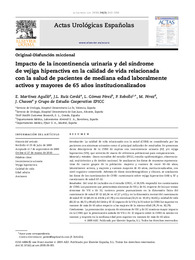Resumen :
Introducción: La calidad de vida relacionada con la salud (CVRS) es considerada por los pacientes con síntomas urinarios como el principal indicador de resultados. Se presentan datos descriptivos de la CVRS de sujetos con incontinencia urinaria (IU) y/o vejiga hiperactiva (VH), que servirán de marco de referencia poblacional para comparaciones. Material y métodos: Datos extraídos del estudio EPICC, estudio epidemiológico, observacional, multicéntrico y de ámbito nacional. Se analizaron los datos de muestras representativas de cuatro grupos de la población: mujeres y varones de entre 50-64 años, laboralmente activos, y mujeres y varones mayores de 65 años, institucionalizados, con nivel cognitivo conservado. Además de datos sociodemográficos y clínicos, se analizaron los datos de los cuestionarios de CVRS: cuestionario sobre vejiga hiperactiva OAB-q SF y cuestionario de salud SF-12. Resultados: Del total de incluidos en el estudio EPICC, el 26,53% respondió los cuestionarios de CVRS. Los pacientes que presentaban síntomas de VH y de IU, respecto de los que tenían síntomas de VH o de IU, tuvieron peores puntuaciones en la dimensión física del cuestionario de salud SF-12 (41,34 vs. 47,17 y 45) y en la dimensión mental del cuestionario de salud SF-12 (46,01 vs. 49,04 y 47,78) y en síntomas (32,21 vs. 19,19 y 16,65) y calidad de vida (82,32 vs. 86,72 y 89,45) del OAB-q SF. El impacto de la VH y la IU sobre la CVRS fue superior en varones de más de 65 años respecto a las mujeres de la misma edad (76,76 vs. 82,79). Conclusiones: La presentación conjunta de síntomas de VH y de IU ocasiona mayor impacto en la CVRS que la presentación aislada de VH o IU. El impacto sobre la CVRS es similar en varones y mujeres en la mediana edad pero superior en varones de más de 65 años.
Introduction: Health-related quality of life (HRQoL) is considered by patients with urinary symptoms as the main outcome variable. Descriptive data about HRQoL in patients with urinary incontinence (UI) and/or overactive bladder (OAB) are reported. These data may serve as a reference for comparison purposes. Materials and methods: Data were taken from EPICC, a national, multicenter, observational, epidemiological study. Data from representative samples of four population groups were analyzed: working patients of both sexes aged 50-64 years, and institutionalized elderly patients of both sexes with no cognitive impairment. In addition to demographic and clinical data, HRQoL data from the Overactive Bladder Questionnaire (OAB-q SF) and the SF-12 Health Survey were also analyzed. Results: Of the total patients in the EPICC study, 26.53% completed the HRQoL questionnaires. Patients with both UI and OAB symptoms had poorer scores than those with OAB or UI respectively in the PCS (41.34 vs. 47.17 and 45) and MCS (46.01 vs. 49.04 and 47.78) of the SF-12, and in the symptom (32.21 vs. 19.19 and 16.65) and quality of life (82.32 vs. 86.72 and 89.45) dimensions of the OAB-q SF. Impact of OAB and UI on HRQoL was higher in men over 65 years of age as compared to women of the same age (76.76 vs. 82.79). Conclusions: Concurrent symptoms of both UI and VH have a greater impact on HRQoL than those of either UI or VH alone. Impact on HRQoL is similar in middle-aged men and women, but higher in elderly men.
|
 La licencia se describe como: Atribución-NonComercial-NoDerivada 4.0 Internacional.
La licencia se describe como: Atribución-NonComercial-NoDerivada 4.0 Internacional.
.png)
